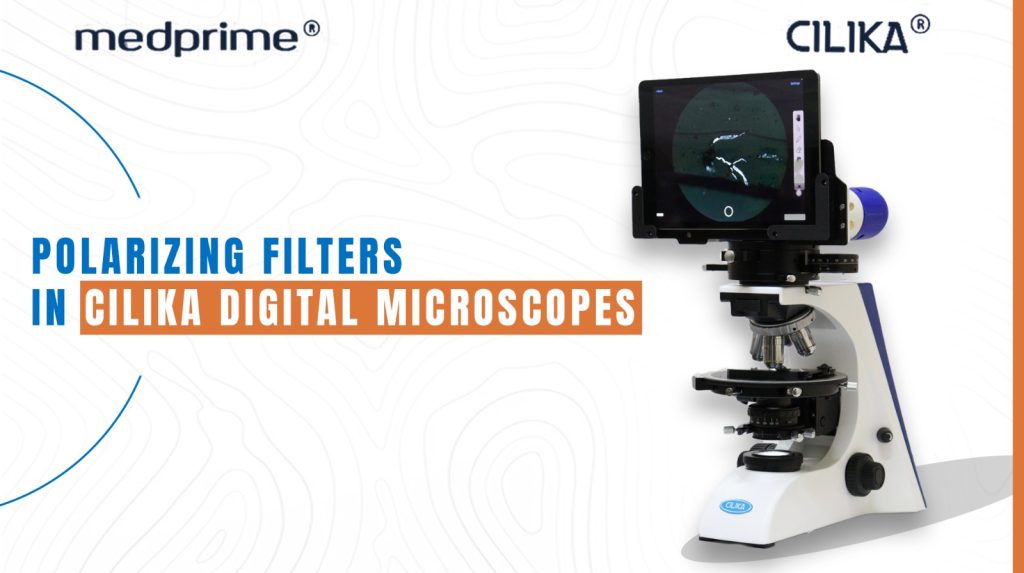The Concept of Polarizing Filters
Polarizing microscopes are used to observe crystals, minerals, and other semi-transparent and transparent materials. They help analyze the structure and properties of these elements. Polarizing microscopes employ polarized light to view specimens. They usually comprise a microscope body with an objective lens and eyepiece, a light source, and a couple of polarizing filters. These polarizing filters, or polarizers are positioned at the light source and at the eyepiece. They are oriented in a way that polarizers remain perpendicular to each other.
When the user places a specimen between the polarizers, it reflects or absorbs the polarized light distinctly based on its properties. While the analyzer remains static, the user can rotate the polarizer. In different locations, positions, or angles, the material will exhibit distinct properties. Here, the polarizer helps the user determine the structure.
It allows the user to observe the specimen’s internal structure and properties. Polarizing filters can be used in digital microscopes owing to the various advantages they offer. Let’s look at some vital aspects of polarizing filters and their use in digital microscopes.
The Science of Polarized Microscopes – Overview
A polarized light microscope allows for the observation and photography of specimens, primarily due to their optically anisotropic character. The microscopes have a polarizer positioned in the light path before the specimen, and an analyzer in the optical pathway between the objective rear aperture and the observation tubes or camera port.
The image contrast generates from the interaction of a plane-polarized light with a birefringent (or doubly-refracting) specimen to produce two individual wave components polarized in mutually perpendicular planes. The velocities of these components are different and differ with the propagation direction via the specimen. After exiting the specimen, the light components become out of phase. However, they are recombined with constructive and destructive interference when they pass via the analyzer.
How Do Polarizing Filters Work?
Here’s how you examine a specimen through a polarizing filter.
- Set up the illumination and then rotate the 10X objective lens into position on the nosepiece.
- If required, you may push the analyzer into place to align it with the light path.
- Before you place the specimen on the stage, slowly rotate the polarizer until the field of the view becomes optimally dark.
- Now, rotate the polarizer at about 90, 180, and 270 degrees and then back to the 0-degree position.
- When viewed through the oculars, the field looks bright when the polarizer and analyzer’s directions are parallel.
- The field darkens as you rotate one of the filters to a 90-degree angle.
- Position the specimen on the stage and repeat the above process. In case your substance under observation consists of birefringent material, you will notice it brighten or darken as you rotate the polarizer.
Polarizing Filters in Cilika Digital Microscopes
Like with all other kinds of microscopy, Cilika takes polarized light microscopy to the next level with its digitization capabilities. Combining the high-resolution imaging that is associated with Cilika, with the specificity and sensitivity that polarized light microscopy can provide, Cilika’s digital polarizing microscopes can make work much faster and efficient. Cilika digital microscopes’ TrueView technology make it possible for the user to see the image on the monitor exactly as they would see it through the eyepiece. In this case, there’s no area loss. The user can capture the image field immediately on the live slide. In addition, they can annotate the image and make the findings more informative.
Applications of Polarizing Filters in Microscopy
Some applications of polarizers in digital microscopes include the following.
- Study of rocks
- Study of minerals
- Identification of crystals and other contaminants in urine samples
- Detection of crystals in synovial fluid (gout)
- Detection of amyloid proteins
- Observation of liquid crystals
- Determining the properties of emulsions
- Studying defects in glass and ceramics
Choosing the Right Polarizing Filter for Your Cilika Microscope
Usually, there are no specific criteria for selecting the right polarizing filter. However, one must note that the wavelength plays a crucial role. For instance, if you want to view for half wavelength, you may choose Lambda with 2 filters, Lambda with 4 filters, etc. Accordingly, users use varying filters to view different wavelengths.
Leverage Next-Generation Microscopy with Cilika Digital Microscopes
Cilika digital microscopes are exemplary microscopes with remarkable capabilities to help simplify microscopy and make it even more effective.
While portable, these microscopes feature an ergonomic design that addresses physical problems stemming from the prolonged use of conventional microscopes. Secondly, these are equipped with Cilika’s patented TruView technology that helps capture 100 percent of the circular field exactly as the view. Additionally, these microscopes enable digital micrometry and annotation, provide high-resolution imaging, and offer multi-device connectivity with remote viewing and data transfer.
Partnering with Medprime refers to leveraging futuristic digital microscopy. If you feel intrigued with our offerings, connect with us at contact@medprimetech.com, and our experts will gladly discuss your unique needs to provide an exclusive solution.
